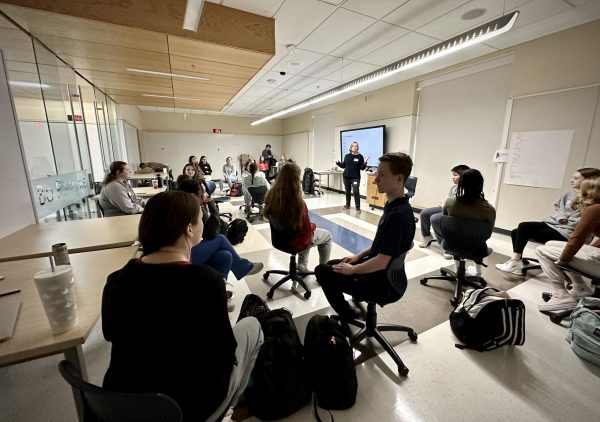Roe v. Wade Overturned: What it Means for Women
Dwain Currier (Creative Commons)
Protestors, such as these female activists, have taken to the streets to defend Roe v Wade.
May 17, 2022
Roe v. Wade was a Supreme Court case finalized in 1973 amidst swirling controversies (most of which attributed to the rise of conservative and evangelical values in a Republican-dominated government). The landmark case ruled in a 7-2 decision that state laws prohibiting abortions inflicted on the 14th Amendment’s guarantee of personal privacy. Thus, the right for women to terminate a pregnancy (conditionally) was henceforth legal.
For nearly five decades since, women have reaped the benefits of being able to cease any undesired pregnancy safely. Whether a result of sexual assault, personal ambition, or otherwise, Roe v. Wade has ensured that women be given the choice to determine bodily and reproductive decisions without legal interference.
Until now.
On May 2, a confidential Supreme Court draft opinion leaked to the media that poses a significant threat to this very right. In this 98-page document, Justice Samuel Alito wrote, “It is time to heed to Constitution and return the issue of abortion to the people’s elected representatives.” A conservative court majority, including Alito, heavily indicates that Roe v Wade will be overturned by the summer.
The decision whether or not to bear a child is central to a woman’s life, to her well-being and dignity. When the government controls that decision for her, she is being treated as less than a full adult human responsible for her own choices.
— Justice Ruth Bader Ginsburg
This leak is nearly unprecedented in modern history; the reality that strictly confidential documents were shared with the general public before their set date is utterly unfathomable. While the exact source of the leak remains confidential, they were described as “familiar with the court’s proceedings in the Mississippi case” by Politico, the primary reporting news source following the incident.
Furthermore, while unlikely to change, the decision is not yet final. Uncertainty surrounding the case only fuels the current state of American social pandemonium as the official court ruling looms.
Not only is the leak itself revolutionary, but also the sheer weight of what overturning Roe means for women nationwide. A 2022 study conducted by the University of Colorado Boulder found that following the finalization of the abortion ban, America will experience a 21 percent increase in pregnancy-related deaths. Without access to Planned Parenthood or other similar organizations, women who wish to terminate their pregnancy will be subjected to much more dangerous methods, putting themselves at further risk.
“Banning abortions does not decrease the number of abortions, it never has,” attested one Franklin High School student. “It only increases the number of unsafe abortions that can either kill the woman or destroy her reproductive organs.”

Assuming that such haphazard methods are not attempted, the question then becomes this… what next? A lack of financial means to support a baby or reliance on a flawed foster care system point to uncertain futures for a majority of these births. According to Census data, there are over 400,000 American children, ranging from infants to 21 years old, currently in foster care. Of those, a mere 29 percent are currently awaiting adoption. Not only is abortion necessary to protect the livelihoods of pregnant women (particularly in dire situations), but their babies if successfully delivered.
“Unwanted children who are born may go into the foster system or be raised in homes with negligent parents,” shared another FHS student. “I feel as though we are moving backward after years of progress in women’s freedoms.”
Finally, the Roe v Wade overruling reveals a glaring discrepancy between personal opinion and the legal system: the separation between church and state. Conservative Justice Amy Coney Barrett has asserted that her “personal church affiliation or religious belief would not bear in the discharge of [her] duties as a judge.” All other Supreme Court Justices, regardless of ideological affiliation, have made similar statements. However, of the nine current Justices, five are Catholic conservatives; these five are the very same who have publicly spoken of their desire to overturn Roe.
It is not a man’s place to decide what a woman can and cannot do. We have come too far to go back. Stand with Roe!
— Anonymous FHS Student
This is not to say that all religions disagree with abortion, nor that this is the only accurate interpretation of the Catholic Bible. To assert that all religious individuals, whether in governmental positions or otherwise, disagree with abortion is to overgeneralize the truth. The choice to abort an undesired pregnancy, whether for religious reasons or otherwise, is that of solely the woman involved. However, these trends are impossible to ignore, and point to the unlawful integration of religious values into a secular government.
“People should not be able to force their religious beliefs through the law,” says Senior Lily Antonellis on the matter. “Religion does not belong in our legislation.”
Currently, women hold 39 percent of Supreme Court seats. 97 percent of women have admitted to being sexually harassed according to a 2021 study by UN Women UK. No matter one’s personal opinions regarding abortion, of which they are fully entitled to, the overturning of Roe v Wade is yet another obstacle in the path of women as they continue to fight for full equality nationwide.

















